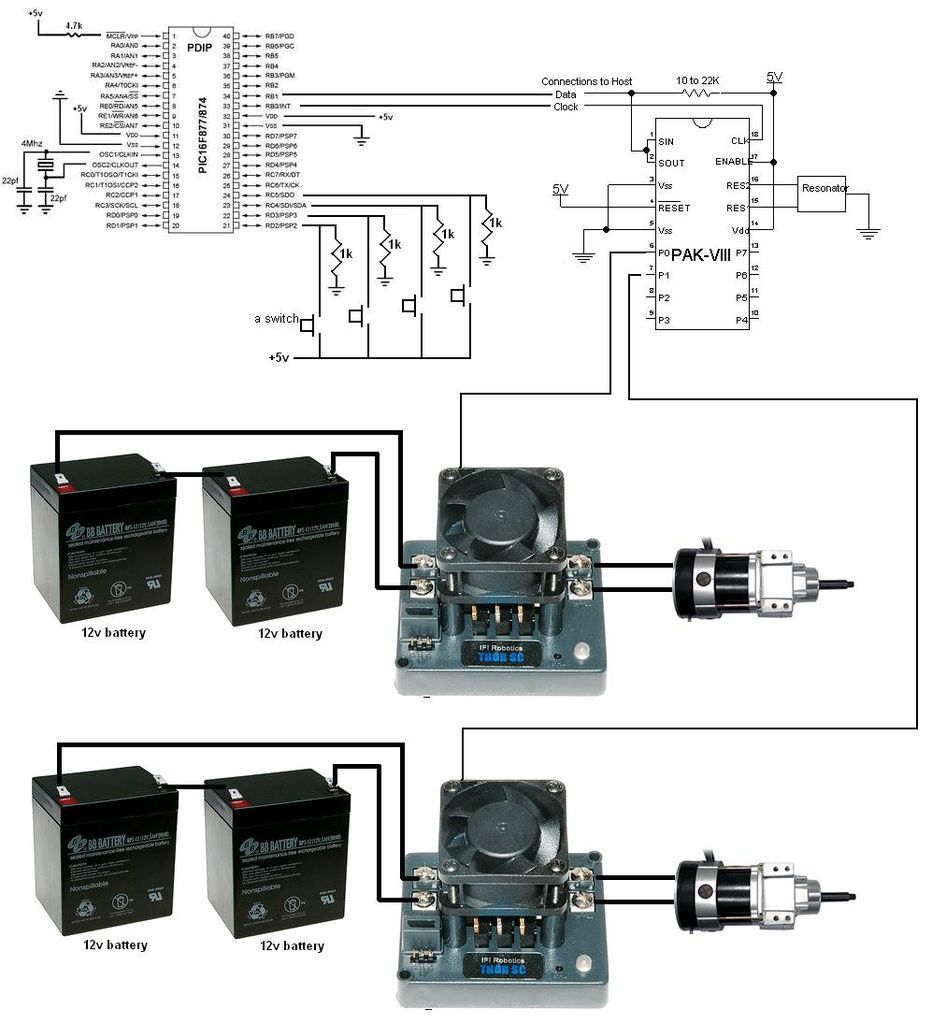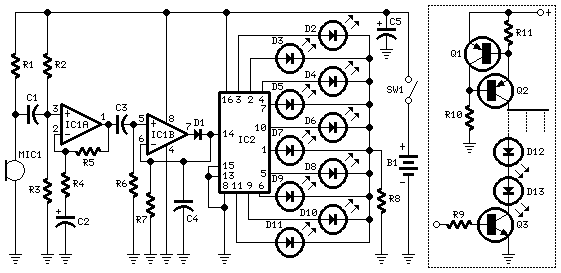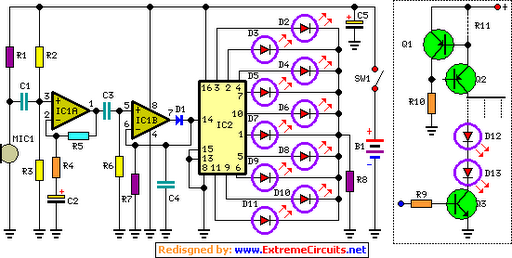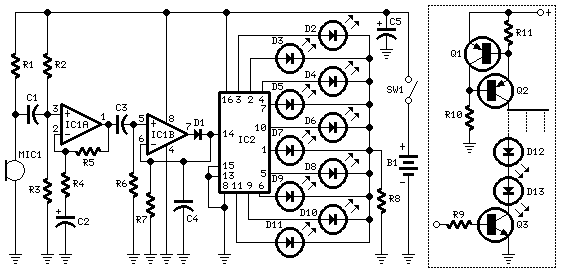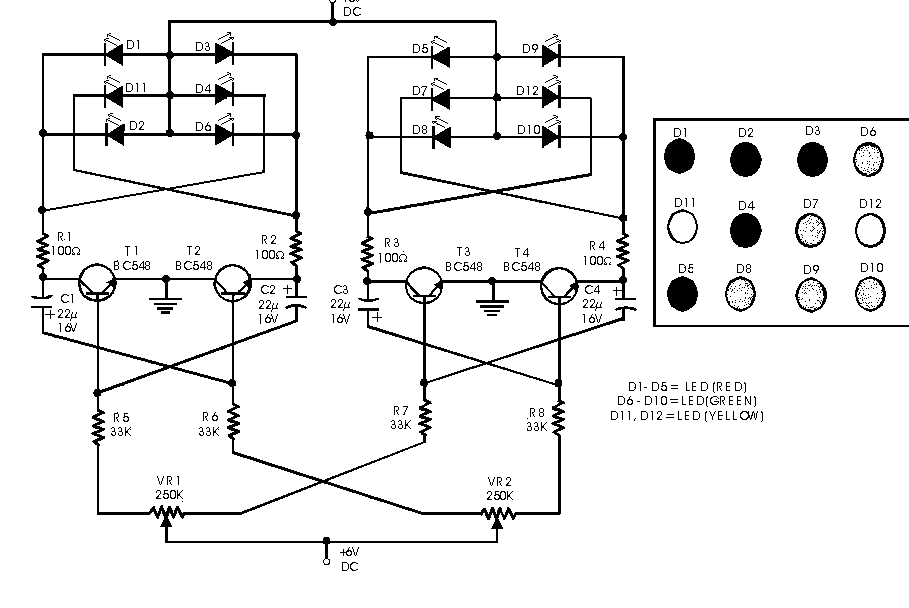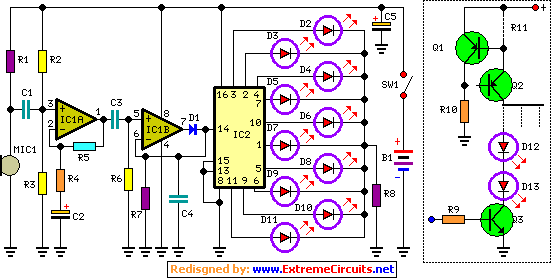
Dancing LEDsCircuit
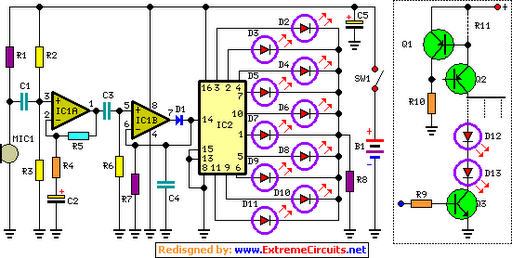
The basic circuit illuminates up to ten LEDs in sequence, following the rhythm of music or speech picked up by a small microphone. The expanded version can drive up to ten strips, each formed by up to five LEDs, at a 9V supply. IC1A amplifies the audio signal captured by the microphone by approximately 100 times and drives IC1B, which functions as a peak-voltage detector. Its output peaks are synchronized with the peaks of the input signal and clock IC2, a ring decade counter capable of driving up to ten LEDs in sequence. An additional circuit allows the driving of up to ten strips made up of five LEDs each (maximum), at a 9V supply. This circuit includes a 10mA constant current source (Q1 & Q2) common to all LED strips and a switching transistor (Q3) that drives a strip consisting of 2 to 5 series-connected LEDs. Consequently, one transistor and its base resistor are required to drive each of the strips used. When adopting the additional circuit, only one component each for R10, R11, Q1, and Q2 is necessary to drive up to ten LED strips. Conversely, one component each of R9 and Q3 is required to drive each of the strips selected. For instance, if five LEDs are used, pin #15 of IC2 must be connected to pin #1; if eight LEDs are chosen, pin #15 of IC2 must be connected to pin #9, and so forth. If a wall-plug adapter is preferred over a 9V battery, the circuit can be powered at 12V, allowing the use of up to six LEDs per strip, or at 15V, permitting the use of up to seven LEDs per strip.
The described circuit functions as a visual display that responds to audio signals, effectively translating sound into light patterns. The core of the circuit is based on an audio detection and amplification mechanism using operational amplifiers. IC1A serves as the first stage of amplification, boosting the microphone's audio signal significantly to ensure clear detection of signal peaks. IC1B, acting as a peak detector, processes the amplified signal to generate a corresponding output that is in sync with the audio peaks, which is then used to clock IC2.
IC2 is a ring decade counter, which sequentially activates outputs corresponding to the detected audio peaks. This allows for the illumination of LEDs in a visually appealing manner, creating a dynamic display that corresponds to the rhythm and intensity of the sound input. The additional circuit for driving LED strips is particularly noteworthy, as it allows for increased versatility in the design. By utilizing a constant current source formed by Q1 and Q2, the circuit ensures that the LED strips receive a stable current, which is crucial for consistent brightness and performance.
The switching transistor Q3 plays a pivotal role in controlling the activation of each LED strip. By connecting the appropriate resistors (R9 and the base resistor for Q3) for each strip, the circuit can be tailored to accommodate different configurations of LED strips, enhancing flexibility in design. The choice of power supply voltage also adds to the circuit's adaptability; by supplying the circuit at higher voltages (12V or 15V), users can increase the number of LEDs per strip, allowing for more complex and visually striking displays.
Overall, this circuit design exemplifies an efficient approach to creating an audio-responsive LED display, with considerations for scalability and customization, making it suitable for various applications in decorative lighting and visual effects.The basic circuit illuminates up to ten LEDs in sequence, following the rhythm of music or speech picked-up by a small microphone. The expanded version can drive up to ten strips, formed by up to five LEDs each, at 9V supply. IC1A amplifies about 100 times the audio signal picked-up by the microphone and drives IC1B acting as peak-voltage detector
. Its output peaks are synchronous with the peaks of the input signal and clock IC2, a ring decade counter capable of driving up to ten LEDs in sequence. An additional circuit allows the driving of up to ten strips, made up by five LEDs each (max. ), at 9V supply. It is formed by a 10mA constant current source (Q1 & Q2) common to all LED strips and by a switching transistor (Q3), driving a strip obtained from 2 to 5 series-connected LEDs.
Therefore one transistor and its Base resistor are required to drive each of the strips used. Adopting the additional circuit, only one item for R10, R11, Q1 and Q2 is required to drive up to ten LED strips. On the contrary, one item of R9 and Q3 is necessary to drive each of the strips you decided to use. For example: if you decided to use 5 LEDs, pin #15 of IC2 must be connected to pin #1; if you decided to use 8 LEDs, pin #15 of IC2 must be connected to pin #9 etc.
Whishing to use a wall-plug adapter instead of a 9V battery, you can supply the circuit at 12V, allowing the use of up to 6 LEDs per strip, or at 15V, allowing the use of up to 7 LEDs per strip. 🔗 External reference
The described circuit functions as a visual display that responds to audio signals, effectively translating sound into light patterns. The core of the circuit is based on an audio detection and amplification mechanism using operational amplifiers. IC1A serves as the first stage of amplification, boosting the microphone's audio signal significantly to ensure clear detection of signal peaks. IC1B, acting as a peak detector, processes the amplified signal to generate a corresponding output that is in sync with the audio peaks, which is then used to clock IC2.
IC2 is a ring decade counter, which sequentially activates outputs corresponding to the detected audio peaks. This allows for the illumination of LEDs in a visually appealing manner, creating a dynamic display that corresponds to the rhythm and intensity of the sound input. The additional circuit for driving LED strips is particularly noteworthy, as it allows for increased versatility in the design. By utilizing a constant current source formed by Q1 and Q2, the circuit ensures that the LED strips receive a stable current, which is crucial for consistent brightness and performance.
The switching transistor Q3 plays a pivotal role in controlling the activation of each LED strip. By connecting the appropriate resistors (R9 and the base resistor for Q3) for each strip, the circuit can be tailored to accommodate different configurations of LED strips, enhancing flexibility in design. The choice of power supply voltage also adds to the circuit's adaptability; by supplying the circuit at higher voltages (12V or 15V), users can increase the number of LEDs per strip, allowing for more complex and visually striking displays.
Overall, this circuit design exemplifies an efficient approach to creating an audio-responsive LED display, with considerations for scalability and customization, making it suitable for various applications in decorative lighting and visual effects.The basic circuit illuminates up to ten LEDs in sequence, following the rhythm of music or speech picked-up by a small microphone. The expanded version can drive up to ten strips, formed by up to five LEDs each, at 9V supply. IC1A amplifies about 100 times the audio signal picked-up by the microphone and drives IC1B acting as peak-voltage detector
. Its output peaks are synchronous with the peaks of the input signal and clock IC2, a ring decade counter capable of driving up to ten LEDs in sequence. An additional circuit allows the driving of up to ten strips, made up by five LEDs each (max. ), at 9V supply. It is formed by a 10mA constant current source (Q1 & Q2) common to all LED strips and by a switching transistor (Q3), driving a strip obtained from 2 to 5 series-connected LEDs.
Therefore one transistor and its Base resistor are required to drive each of the strips used. Adopting the additional circuit, only one item for R10, R11, Q1 and Q2 is required to drive up to ten LED strips. On the contrary, one item of R9 and Q3 is necessary to drive each of the strips you decided to use. For example: if you decided to use 5 LEDs, pin #15 of IC2 must be connected to pin #1; if you decided to use 8 LEDs, pin #15 of IC2 must be connected to pin #9 etc.
Whishing to use a wall-plug adapter instead of a 9V battery, you can supply the circuit at 12V, allowing the use of up to 6 LEDs per strip, or at 15V, allowing the use of up to 7 LEDs per strip. 🔗 External reference
Warning: include(partials/cookie-banner.php): Failed to open stream: Permission denied in /var/www/html/nextgr/view-circuit.php on line 713
Warning: include(): Failed opening 'partials/cookie-banner.php' for inclusion (include_path='.:/usr/share/php') in /var/www/html/nextgr/view-circuit.php on line 713
